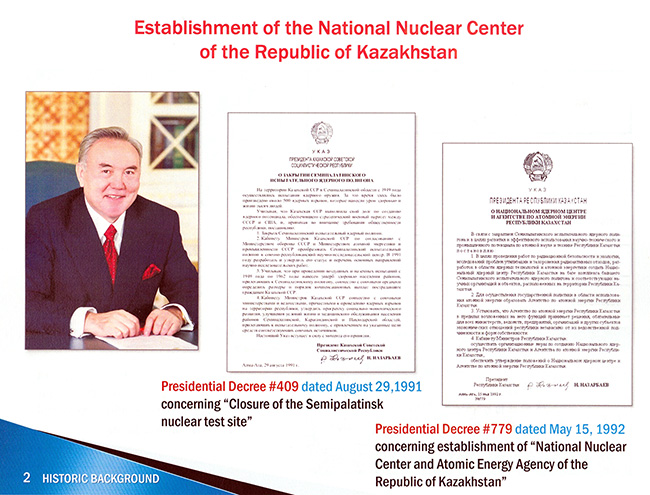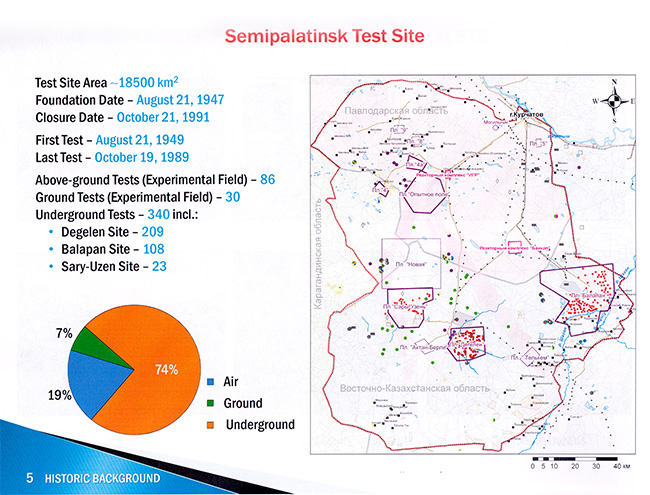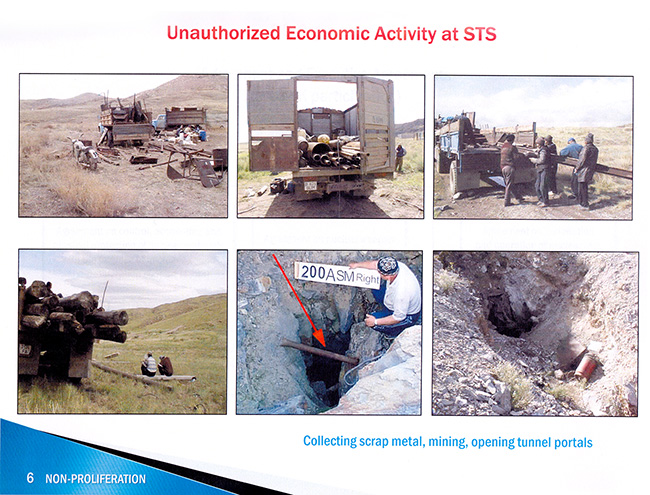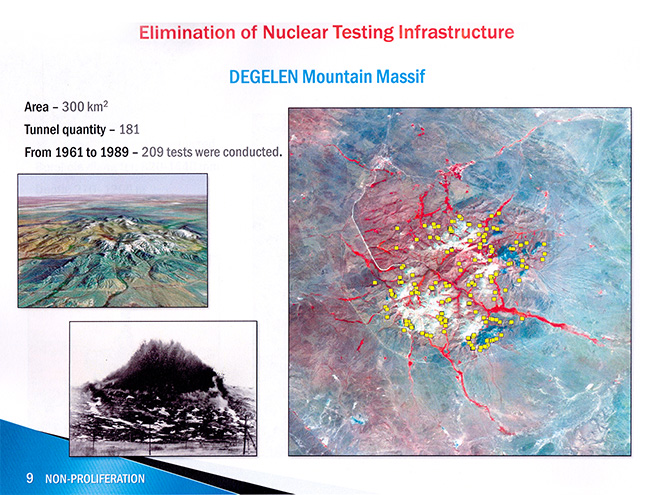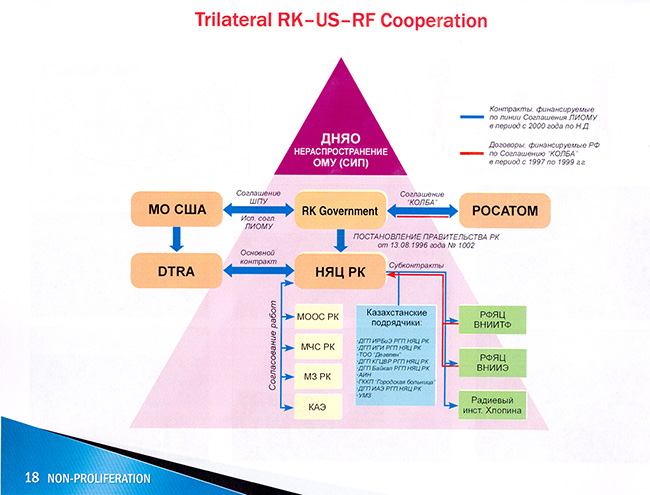Related Materials
Nunn-Lugar Revisited
U.S.-Russian cooperation on threat reduction from the Soviet Union in 1991 to Syria in 2013
National Security Archive Electronic Briefing Book No. 447
Project Sapphire 20th Anniversary
More than a half-ton of weapons-grade uranium removed from Kazakhstan in 1994
National Security Archive Electronic Briefing Book No. 491
Photos
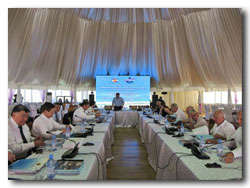
1. The Bal Qar Gai conference “yurt.” Tom Blanton at the head of the conference table. |
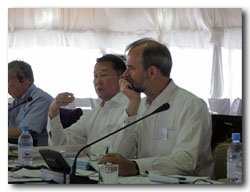
2. Ambassador Kenneth Fairfax with Ambassador Bolat Nurgaliev at a session in Bal Qar Gai |
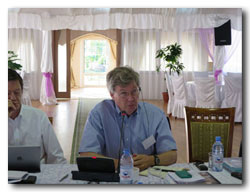
3. Ambassador Courtney at the conference table |
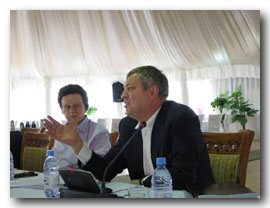
4. Vladimir Shkolnik and Bill Potter at the BW session. |
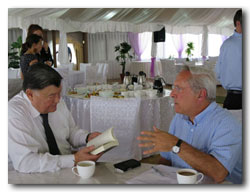
5. Kairat Kadyrzhanov and David Hoffman discuss David’s book The Dead Hand. |
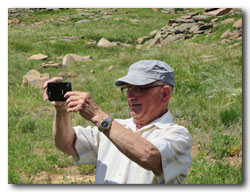
6. General Anatoly Svetikov takes photos of Degelen Mountain. |
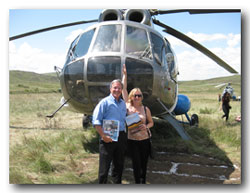
7. Conference organizers Tom Blanton and Svetlana Savranskaya at Degelen Mountain. |
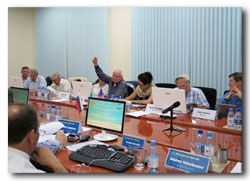
8. General Evgeny Maslin speaks at the session at the National Nuclear Center in Kurchatov. |
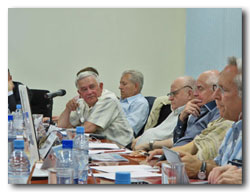
9. General Anatoly Svetikov responds to David Hoffman at the National Nuclear Center surrounded by Generals Vassily Lavrishchev, Viktor Yesin, Evgeny Maslin. |
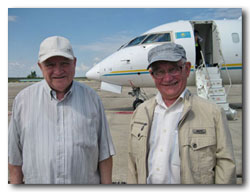
10. Generals Viktor Yesin and Anatoly Svetikov at the Semipalatinsk airport. |
.jpg)
11. Map of the helicopter flight the conference participants took over Semipalatinsk Polygon. |

12. At the Degelen Memorial: David Hoffman, John Ordway, Andy Weber, Barlybay Sadykov, Kenneth Fairfax, Erlan Batyrbekov and Sergey Berezin. |
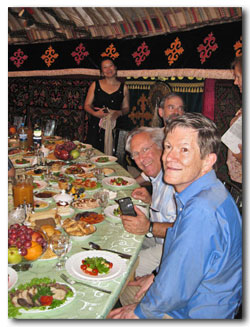
13. Dinner at the ceremonial yurt at the National Nuclear Center in Kurchatov: John Ordway, David Hoffman, Kenneth Fairfax, Togzhan Kassenova. |
|
Washington D.C., August 29, 2015 – Today’s anniversary of the historic closing in 1991 of the Soviet Union’s nuclear test site at Semipalatinsk has brought new public attention to more than 20 years of U.S., Russian and Kazakh cooperation to remove and clean up after nuclear weapons – the subject of a landmark conference earlier this summer organized by the National Security Archive.
In May 1992 meetings with then-U.S. president George H.W. Bush, the president of the newly independent former Soviet republic, Nursultan Nazarbayev, had committed Kazakhstan to a non-nuclear future and the removal of more than 1,000 former Soviet nuclear warheads still on Kazakh territory. Earlier, in August 1991, Nazarbayev (then the head of the Kazakh Communist Party) had decreed the closure of the Semipalatinsk test site, thus signaling his agreement with the popular Nevada-Semey movement that protested the human and environmental damage from decades of nuclear tests.
Trilateral RK-US-RF Cooperation at the Former Semipalatinsk Test Site (Slides from Dr. Erlan Batyrbekov's presentation at the National Nuclear Center)
The close cooperation of the Russian military, together with funding from the visionary (but underappreciated) Nunn-Lugar program in the U.S., successfully removed all the Soviet-era warheads from Kazakhstan by 1995. Subsequently, Nunn-Lugar funding also underwrote nearly two decades of scientific cooperation involving Russian and American institutes together with the Kazakh National Nuclear Center to clean up and secure hundreds of radioactive underground sites of test explosions in multiple locations in the “Polygon” (the test site nickname after its shape on the map).
Kazakhstan has since become a global leader for non-proliferation of weapons of mass destruction, noted for its playing prominent roles at the most recent Nuclear Security Summits, its plan to host the International Atomic Energy Agency’s (IAEA) low-enriched-uranium fuel bank (with support from Sam Nunn’s Nuclear Threat Initiative), and the new home in Astana for the International Science and Technical Center after Moscow pulled out of Nunn-Lugar programs in 2013. The IAEA and the Kazakh government formally signed the fuel bank agreement on August 27, 2015 in Astana with Senator Nunn present for the occasion. Nunn commented, “We are in a race between cooperation and catastrophe.”
Veterans of the Kazakh success story gathered in Astana in early June for the second in the series of “critical oral history” conferences organized by the National Security Archive to illuminate the history of the Nunn-Lugar initiative and bring its lessons to bear on current and future proliferation challenges.
The Russian delegation, headed by Col. Gen. Evgeny Maslin (former head of the 12th directorate of the General Staff, in charge of nuclear warheads), included the former chief of staff of the Strategic Rocket Forces, Col. Gen. Victor Yesin, senior Russian nuclear expert Maj. Gen. Vasily Lavrishchev, and Maj. Gen. Anatoly Svetikov who both accompanied President Nazarbayev to the 1992 Washington meetings and later commanded the actual withdrawal of warheads from Kazakhstan.
The American delegation, headed by White House senior director for non-proliferation Laura Holgate (subsequently nominated by President Obama to be U.S. ambassador to the IAEA), included the first U.S. ambassador to Kazakhstan, William Courtney, and two of his successors, John Ordway and Kenneth Fairfax, together with non-proliferation expert William Potter from the Middlebury Institute of International Studies at Monterey. The former assistant secretary of defense for WMD, Andy Weber, brought to the table his personal experience inidentifying and removing highly enriched uranium, as well as inspecting former Soviet bioweapon facilities left in Kazakhstan; and Pulitzer-Prize-winning author David Hoffman also provided expertise dating back to his 1991 trip with then-Secretary of State James Baker to Kazakhstan.
The conference’s formal sessions included Kazakh Foreign Minister Erlan Idrissov and Senate Chairman Kassym-Jomart Tokayev, who gave their perspectives on the historic decisions taken by Kazakhstan in the 1990s and thereafter. Energy Minister Vladimir Shkolnik – who played a key role both in the 1990s and in the organization of the conference – participated in both ceremonial and discussion sessions.
Key Kazakh veterans who came to the table included former Deputy Foreign Minister Bolat Nurgaliev, former head of the Nuclear Center Dr. Kairat Kadyrzhanov, the long-time head of the military's verification center Col. Assylbek Mendygalyev and his successor Col. Amangeldy Aubakirov, current ambassador for non-proliferation Barlybey Sadykov, and deputy director of the Nuclear Center Sergei Berezin.
The conference’s formal sessions were hosted by the Foreign Ministry of Kazakhstan, with the group portrait of participants on the main stairway of the Ministry in downtown Astana. The first two days of discussion sessions took place at the Bal Qar Gai horse-riding resort outside of Astana, in the large yurt-style wedding hall of the facility.
The Kazakh Ministry of Energy hosted the conference participants on a charter flight from Astana to Semey on the third day of the conference, and on a helicopter journey (in Soviet-built Mi-8 choppers) over the former test site, including a view of Ground Zero and a ceremonial stop on top of Degelen Mountain, where teams of Russian, Kazakh and American scientists worked for years to clean up and secure former underground testing tunnels.
The National Nuclear Center of Kazakhstan provided its state-of-the-art conference room for one of the discussion sessions after the helicopter trip, along with lunch in the former Kurchatov Institute cafeteria, tours of the Institute’s museum documenting all the Soviet tests, and a ceremonial Kazakh feast inside a yurt erected for the occasion on the grounds.
Perhaps the most impressive presentation of the entire conference came from the Nuclear Center’s director general, Dr. Erlan Batyrbekov, during the discussion at Kurchatov. Dr. Batyrbekov provided the participants with a 24-slide PowerPoint talk summarizing the “Trilateral RK-US-RF Cooperation at the Former Semipalatinsk Test Site,” detailing the history of nuclear testing (with specific numbers of tests, boreholes, dates and locations), the dangers of proliferation by scavengers after the collapse of the Soviet Union, the wide range of the Center’s initiatives, and the ongoing radiological monitoring and remediation activities.
Other conference sessions covered the landmark decisions made by the Kazakh leadership in the early 1990s to join the Nuclear Non-Proliferation Treaty and remove the nuclear, chemical and biological weapons and infrastructure left by the Soviet Union. Specific topics included the Project Sapphire removal of enough highly-enriched uranium to make a score of nuclear weapons, the decommissioning of the Soviet-era BN-350 reactor with secure storage of the downgraded fuel on the territory of the former test site, and the challenges of cleanup at the Stepnogorsk anthrax factory and the Vozrozhdeniye Island bioweapons test site.
The conference briefing book, compiled by the National Security Archive team (Svetlana Savranskaya, Tom Blanton, Malcolm Byrne, Anna Melyakova, Rinat Bikineyev, Peter Oster and Chris Johnson) included the actual declassified transcript of the May 1992 Bush-Nazarbayev meeting, together with highest-level memcons, cables and reports covering the crucial early years (1991-1995) of Nunn-Lugar-funded cooperative threat reduction in Kazakhstan. The primary sources also included several of Ambassador Courtney’s influential cables, and discussions between Russian president Boris Yeltsin and U.S. presidents Bush and Clinton in the 1990s.
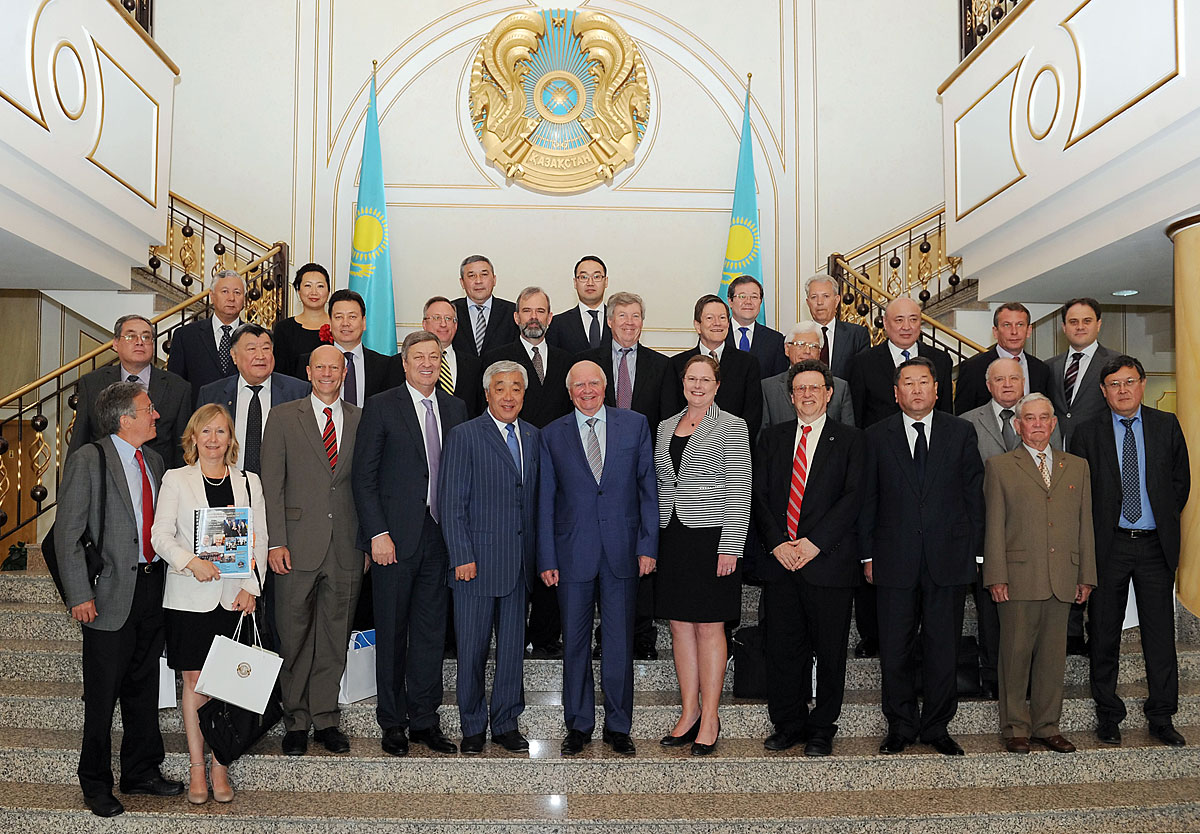
Conference participants at the Ministry of Foreign Affairs, Astana, Kazakhstan
Front row: Archive director Tom Blanton, Archive Russia programs director Svetlana Savranskaya, former assistant secretary of defense Andy Weber, minister of energy Vladimir Shkolnik, foreign minister Erlan Idrissov, Col. Gen. Evgeny Maslin, White House senior director Laura Holgate, professor William Potter, former deputy foreign minister Bolat Nurgaliev, Col. Gen. Viktor Yesin, Maj. Gen. Anatoly Svetikov, nuclear expert Timur Zhantikin.
Second row: Kazakh diplomat Murat Laumulin, former head of the National Nuclear Center Dr. Kairat Kadyrzhanov, Col. Amangeldy Aubakirov, U.S. ambassador George Krol, former ambassador Kenneth Fairfax, former ambassador William Courtney, former ambassador John Ordway, Russian ambassador Mikhail Bocharnikov, ambassador Dastan Eleukenov, deputy director of the National Nuclear Center Sergei Berezin, foreign ministry official Roman Vassilenko.
Third row: Col. Assylbek Mendygalyev, Carnegie Endowment expert Togzhan Kassenova, biohazards expert Dr. Bakhyt Atshabar, deputy foreign minister Erzhan Ashikbayev, ambassador Barlybay Sadykov, Maj. Gen. Vasily Lavrishchev.
Conference Participants
Erzhan Ashikbayev, deputy foreign minister of Kazakhstan, former head of the foreign policy center of the Presidential administration.
Dr. Bakhyt Atshabar, director of the Kazakh scientific center on quarantine and zoonotic diseases, host of new central reference laboratory on biohazards.
Col. Amangeldy Aubakirov, head of the Kazakhstan Ministry of Defense arms reduction control and inspection activities support center.
Dr. Erlan Batyrbekov, director of the National Nuclear Center of Kazakhstan and host of the conference meetings at Kurchatov.
Sergey Berezin, deputy director of the National Nuclear Center of Kazakhstan and veteran of the Degelen Mountain cleanup and other cooperative threat reduction efforts.
Tom Blanton, director of the National Security Archive since 1992, moderator of the conference.
Mikhail Bocharnikov, ambassador of the Russian Federation to Kazakhstan from 2006 to the present.
Dr. William Courtney, first U.S. ambassador to independent Kazakhstan 1992-1994, including the period of non-nuclear decisions and Project Sapphire, now president of the U.S.-Kazakhstan Business Association, fellow at RAND.
Dr. Dastan Eleukenov, Kazakhstan ambassador to Sweden 2014 to present, formerly with the Monterey Institute and the Kazakh embassy in Washington, among other posts.
Kenneth Fairfax, U.S. ambassador to Kazakhstan 2011-2013, author of “holes in the fence” proliferation warnings as a science and technology officer in the U.S. embassy Moscow in 1994.
David Hoffman, former Moscow bureau chief and foreign editor, Washington Post, Pulitzer-Prize-winning author of The Dead Hand: The Untold Story of the Cold War Arms Race and Its Dangerous Legacy.
Laura Holgate, White House National Security Council senior director for weapons of mass destruction terrorism and threat reduction 2009-2015, nominated in 2015 by President Obama as U.S. ambassador to the Vienna office of the United Nations and the IAEA.
Erlan Idrissov, foreign minister of Kazakhstan 2012 to present and 1999-2002, former Kazakh ambassador to the U.S. and to Great Britain, among many other leading posts.
Dr. Kairat Kadyrzhanov, former head of the National Nuclear Center of Kazakhstan, veteran of cooperative threat reduction efforts by American, Russian and Kazakh nuclear weapons scientists.
Dr. Togzhan Kassenova, research associate of the Carnegie Endowment for International Peace.
George Krol, U.S. ambassador to Kazakhstan, former U.S. ambassador to Uzbekistan (2011-2014) and Belarus (2003-2006).
Dr. Murat Laumulin, Kazakh diplomat in Belarus, formerly chief researcher at Kazakhstan Institute for Strategic Studies.
Maj. Gen. Vasily Lavrishchev, retired expert on Soviet and Russian nuclear weapons, veteran of Semipalatinsk.
Col. Gen. Evgeny Maslin, former head of the Russian Ministry of Defense’s 12th Main Directorate (nuclear weapons) from 1992-1997.
Col. Assylbek Mendygalyev, former head of the Kazakhstan military verification center, veteran of the Soviet Strategic Rocket Forces.
Bolat Nurgaliev, former deputy foreign minister of Kazakhstan, former Kazakh ambassador to the U.S., key interlocutor for Project Sapphire and nuclear negotiations.
John Ordway, three tours as head of the U.S. mission to Kazakhstan, including as ambassador 2004-2008, again in 2011, and 2013-2014.
Dr. William Potter, the Sam Nunn and Richard Lugar professor of nonproliferation studies and founding director of the James Martin Center for Nonproliferation Studies at the Middlebury Institute for International Studies at Monterey.
Barlybay Sadykov, ambassador-at-large of Kazakhstan for nuclear nonproliferation and global security issues.
Dr. Svetlana Savranskaya, director of Russia programs for the National Security Archive since 2000.
Dr. Vladimir Shkolnik, minister of energy of Kazakhstan, former head of Kazatom and the science and technology ministry, key Kazakh interlocutor for Project Sapphire and for the opening of the Stepnogorsk anthrax factory, among other initiatives.
Maj. Gen. Anatoly Svetikov, veteran of Soviet and Russian Strategic Rocket Forces, commander of the withdrawal of warheads from Kazakhstan, accompanied President Nazarbayev during 1992 summit meeting in Washington.
Andy Weber, former U.S. assistant secretary of defense for nuclear, chemical and biological defense programs 2009-2014, served in U.S. embassy Kazakhstan in 1994 as lead for Project Sapphire, and for 13 years as advisor to the U.S. secretary of defense for threat reduction.
Col. Gen. Viktor Yesin, former chief of the general staff of the Russian Strategic Rocket Forces 1994-1996, subsequently chief of the Russian Security Council administration 1998-2002.
Dr. Timur Zhantikin, deputy chairman of the atomic energy supervision committee of the ministry of energy of Kazakhstan.
Documents
|
| 1 |
Report from L. Zaikov to Mikhail Gorbachev, “To the President of the USSR: Report on Biological Weapons,” |
May 15, 1990 |
| 2 |
Memorandum of Conversation between George Bush, James Baker, Mikhail Gorbachev, Nursultan Nazarbayev, |
July 30, 1991 |
| 3 |
Article, “Kazakhstan Keeping Nuclear Arms, Republic’s President Tells Baker,” by David Hoffman, The Washington Post, |
December 18, 1991 |
| 4 |
Memorandum of Telephone Conversation between George Bush and Boris Yeltsin, |
December 23, 1991 |
| 5 |
Draft Memorandum, “The U.S. Approach to the FSU: The Next Twelve Months,” |
January 15, 1992 |
| 6 |
Memorandum of Conversation between President Bush and President Yeltsin [Excerpt], |
February 1, 1992 |
| 7 |
National Security Council Memorandum, “Defining American Interests in Kazakhstan,” |
February 18, 1992 |
| 8 |
National Security Council Memorandum, “Defining U.S. Interests in Central Asia,” |
March 6, 1992 |
| 9 |
National Security Council Memorandum, Letter from President Bush to President Nazarbayev, |
March 17, 1992 |
| 10 |
National Security Council Memorandum, “Kazakhstan as Nuclear State?” |
March 20, 1992 |
| 11 |
Cable from AmEmbassy Alma Ata, “Kazakh President Nazarbayev’s Visit to the U.S.,” |
April 8, 1992 |
| 12 |
National Security Council Memorandum, “RLRFE Alma Ata Symposium on Kazakhstan,” |
April 28, 1992 |
| 13 |
Cable from AmEmbassy Alma Ata, “Kazakhstan and Nazarbayev Go Public on the Nuclear Issue,” |
April 29, 1992 |
| 14 |
Cable from AmEmbassy Alma Ata, “The Nuclear Issue and Kazakh President Nazarbayev's Visit to Washington,” |
April 29, 1992 |
| 15 |
Cable from AmEmbassy Alma Ata, “Kazakh Proposal for a Joint Statement in Washington during Nazarbayev Visit” [Excerpt], |
May 6, 1992 |
| 16 |
Cable from FM FBIS, “President Nazarbayev Interviewed,” |
May 6, 1992 |
| 17 |
Cable from AmEmbassy Alma Ata, “Kazakhstan on the Eve of Nazarbayev's Visit to America,” |
May 15, 1992 |
| 18 |
White House Memorandum, “Meeting with President Nursultan Nazarbayev of Kazakhstan,” |
May 18, 1992 |
| 19 |
Letter from President Nazarbayev to President Bush on START, |
May 19, 1992 |
| 20 |
Letter from Secretary of State Baker to President Nazarbayev, |
May 19, 1992 |
| 21 |
National Security Council Memorandum for James Timbie, “Nunn-Lugar Certification for Kazakhstan,” |
May 19, 1992 |
| 22 |
Memorandum of Conversation between President Bush, President Nazarbayev, and Secretary of State Baker, |
May 19, 1992 |
| 23 |
National Security Council Memorandum, “Remarks by the President and President Nazarbayev of Kazakhstan Upon Departure” [Excerpt from Text of Agreements between the United States and the Republic of Kazakhstan], |
May 23, 1992 |
| 24 |
Cable from SecState Washington DC, “Readout from the Official Working Visit of President Nazarbaev to Washington, May 18-20, 1992,” |
May 27, 1992 |
| 25 |
Memorandum, “Certification of Commitments of Kazakhstan: Justification,” |
June 4, 1992 |
| 26 |
Cable from SecState Washington DC, “INR Commonwealth - East European Review May 26-June 2,” |
June 4, 1992 |
| 27 |
Memorandum of Conversation, “First Expanded Meeting with President Boris Yeltsin of Russia on Military and Security Issues” [Excerpt], |
June 16, 1992 |
| 28 |
National Security Council Memorandum, “Letter to the President from Kazakhstan President Nazarbayev,” |
June 19, 1992 |
| 29 |
Cable from AmEmbassy Alma Ata, “Kazakhstan’s Strategic Situation – Looking to the Libby Talks,” |
June 25, 1992 |
| 30 |
National Security Council Memorandum, “Initial SSD Discussions with Kazakhstan,” |
July 11, 1992 |
| 31 |
Cable from AmEmbassy Alma Ata, “Continuation of SSD Dialogue,” |
August 12, 1992 |
| 32 |
Cable from Joint Staff Washington DC, “Disarmament Visits to Alma Ata; Update,” |
August 21, 1992 |
| 33 |
Cable from SecState Washington DC, “Presidential Letter to Kazakhstan President Nazarbayev,” |
August 28, 1992 |
| 34 |
Cable from USDEL Secretary, “Secretary’s Meeting with the Foreign Minister of Kazakhstan, Tolevtay Suleymenov, at the Tokyo Coordinating Conference,” |
October 31, 1992 |
| 35 |
Cable from AmEmbassy Moscow, “SSD: Plenary Meeting – Moscow,” |
November 3, 1992 |
| 36 |
Cable from SecState Washington DC, “Umbrella Agreement for Kazakhstan,” |
November 4, 1992 |
| 37 |
Cable from SecState Washington DC, “TPS for Kazakhstan on GGCL, Accident Response, MC&A,” |
November 4, 1992 |
| 38 |
National Security Memorandum, “SSD: Alma Ata Bilateral Sessions,” |
November 6, 1992 |
| 39 |
National Security Council Memorandum, “Kazakhstan Ready to Sign Non-Proliferation Treaty,” |
November 21, 1992 |
| 40 |
Cable from AmEmbassy Alma Ata, “Codel Nunn/Lugar Meeting with Kazakhstan President Nazarbayev, November 21, 1992,” |
November 23, 1992 |
| 41 |
Cable from SecState Washington DC, “SSD: Draft Agreements for GOK Review,” |
November 25, 1992 |
| 42 |
DTRA Project Sapphire After Action Report, |
November 1994 |
| 43 |
Transcript of Press Conference by Defense Secretary William Perry, Secretary of State Warren Christopher and Energy Secretary Hazel O'Leary on Project Sapphire, |
November 23, 1994 |
| 44 |
Analysis, National Security Program Office, “Analysis of HEU Samples from the Ulba Metallurgical Plant,” |
May 15, 1995 |
| 45 |
Article, “Project Sapphire” by John A. Tirpak, Air Force Magazine Online Vol. 78, No. 8, |
August 1995 |
| 46 |
Article, “The Changing Nuclear Threat: The ‘Sapphire’ File,” by William C. Potter, Transitions Online, |
November 17, 1995 |
| 47 |
Amendment to the Agreement between the Department of Defense of the United States of America and the Ministry of Science and New Technologies of the Republic of Kazakhstan Concerning the Elimination of Nuclear Weapons Infrastructure, |
June 10, 1996 |
| 48 |
Chapter, “Implementing the CTR Program in Kazakhstan,” by Oumirserik Kasenov, Dastan Eleukenov, and Murat Laumulin, |
1997 |
| 49 |
Paper, “Former Soviet Biological Weapons Facilities in Kazakhstan: Past Present and Future,” by Gulbarshyn Bozheyeva, Yerlan Kunakbayev, Dastan Yeleukenov, |
June 1999 |
| 50 |
DTRA Paper, “White Paper on Kazakhstan NNC Radiation Materials Issue,” |
January 13, 2000 |
| 51 |
Outline, “Plan of the Technical Task” [in Russian], |
June 2000 |
| 52 |
Report, “Report of the Trilateral Working Group Meeting of the Technical Experts at the Former Semipalatinsk Test Site (STS),” |
June, 2000 |
| 53 |
Swedish Defense Research Agency Report, “Conversion of former biological weapons facilities in Kazakhstan. A visit to Stepnogorsk, July 2000” by Roger Roffey, Kristina S. Westerdahl, |
May 2001 |
| 54 |
U.S. Department of Energy Report, “U.S. Experience in the Decommissioning of the BN-350 Fast Breeder Reactor in Kazakhstan,” |
2002 |
| 55 |
Department of Defense PowerPoint, “Nunn-Lugar CTR Kazakhstan/Uzbekistan Chemical & Biological Overview,” |
January 2002 |
| 56 |
DTRA Point Paper, “Vozrozhdeniya Island Point Paper,” |
January 2002 |
| 57 |
DTRA Background Paper, “Vozrozhdeniye Island,” |
Undated |
| 58 |
DTRA Project Management Trip Report, “Biological Weapons Proliferation Prevention Outside of Russia,” |
September 2004 |
| 59 |
Chapter, “Project Sapphire,” from The Dead Hand by David E. Hoffman, |
2009 |
| 60 |
Cable from AmEmbassy Astana, “Kazakhstan: A Key Partner on Non-Proliferation” [obtained from Wikileaks], |
September 18, 2009 |
| 61 |
Cable from AmEmbassy Astana, “Current U.S.-Kazakhstani Non-Proliferation Programs” [obtained from Wikileaks], |
October 2, 2009 |
| 62 |
Press Release, “Joint Statement of the Presidents of the Republic Kazakhstan, the Russian Federation and United States of America Regarding the Trilateral Cooperation at the Former Semipalatinsk Test Site” and Fact Sheet, “History of Trilateral Threat Reduction Cooperation at the Former Semipalatinsk Test Site,” |
March 26, 2012 |
| 63 |
Press Release, “Remarks by President Obama, President Medvedev of Russia, and President Nazarbayev of Kazakhstan at Trilateral Announcement,” |
March 27, 2012 |
| 64 |
Report by the Project on Managing the Atom, “Plutonium Mountain: Inside the 17-year Mission to Secure a Dangerous Legacy of Soviet Nuclear Testing,” by Eben Harrell & David Hoffman, |
August 2013 |
| 65 |
“Information on the Work to Implement the Agreement between Kazakhstan and the United States Concerning the Elimination of Biological Weapons Infrastructure” [in Russian], |
2014 |
|


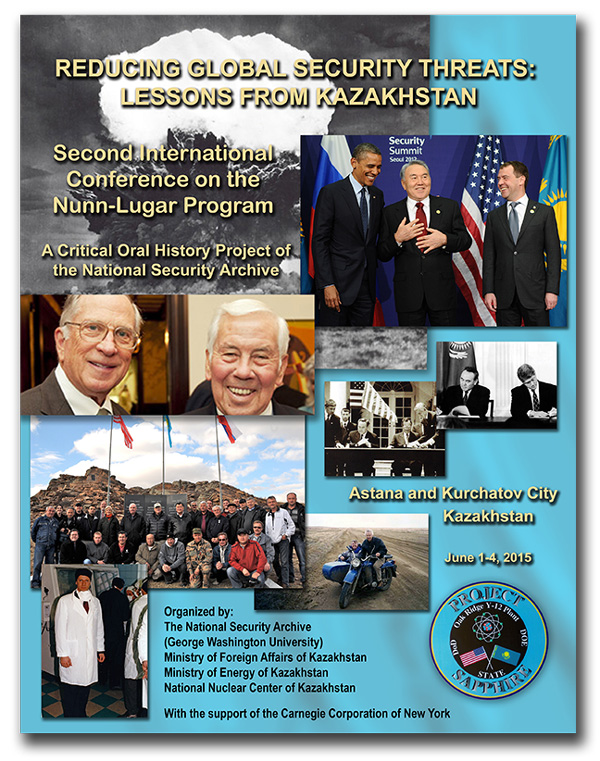










.jpg)


